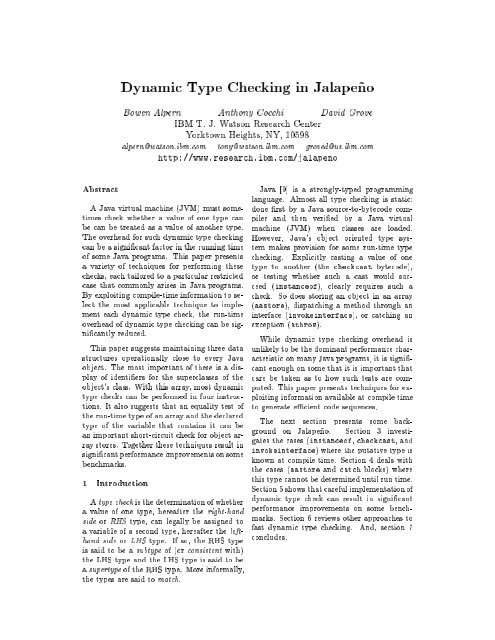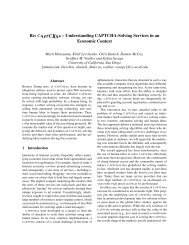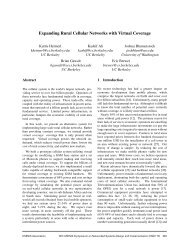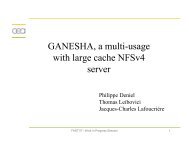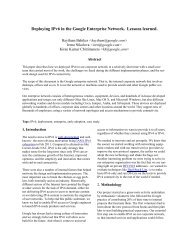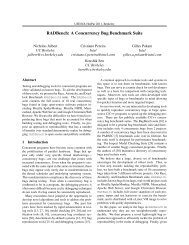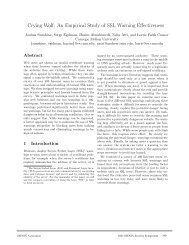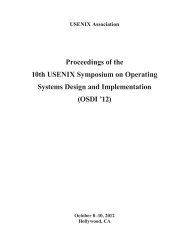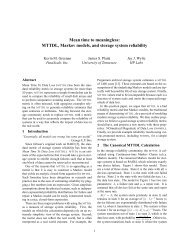Dynamic Type Checking in Jalapeño - Usenix
Dynamic Type Checking in Jalapeño - Usenix
Dynamic Type Checking in Jalapeño - Usenix
You also want an ePaper? Increase the reach of your titles
YUMPU automatically turns print PDFs into web optimized ePapers that Google loves.
Abstract<br />
<strong>Dynamic</strong> <strong>Type</strong> <strong>Check<strong>in</strong>g</strong> <strong>in</strong> Jalape~no<br />
Bowen Alpern Anthony Cocchi David Grove<br />
IBMT.J.Watson Research Center<br />
Yorktown Heights, NY, 10598<br />
alpern@watson.ibm.com tony@watson.ibm.com groved@us.ibm.com<br />
http://www.research.ibm.com/jalapeno<br />
AJava virtual mach<strong>in</strong>e (JVM) must sometimes<br />
check whether a value of one type can<br />
be can be treated as a value of another type.<br />
The overhead for such dynamic type check<strong>in</strong>g<br />
can be a signi cant factor <strong>in</strong> the runn<strong>in</strong>g time<br />
of some Java programs. This paper presents<br />
avariety of techniques for perform<strong>in</strong>g these<br />
checks, each tailored to a particular restricted<br />
case that commonly arises <strong>in</strong> Java programs.<br />
By exploit<strong>in</strong>g compile-time <strong>in</strong>formation to select<br />
the most applicable technique to implement<br />
each dynamic type check, the run-time<br />
overhead of dynamic type check<strong>in</strong>gcanbesigni<br />
cantly reduced.<br />
This paper suggests ma<strong>in</strong>ta<strong>in</strong><strong>in</strong>g three data<br />
structures operationally close to every Java<br />
object. The most important of these is a display<br />
ofidenti ers for the superclasses of the<br />
object's class. With this array, most dynamic<br />
type checks can be performed <strong>in</strong> four <strong>in</strong>structions.<br />
It also suggests that an equality test of<br />
the run-time typeofanarray and the declared<br />
type of the variable that conta<strong>in</strong>sitcanbe<br />
an important short-circuit check for object array<br />
stores. Together these techniques result <strong>in</strong><br />
signi cant performance improvements on some<br />
benchmarks.<br />
1 Introduction<br />
A type check is the determ<strong>in</strong>ation of whether<br />
avalue of one type, hereafter the right-hand<br />
side or RHS type, can legally be assigned to<br />
avariable of a second type, hereafter the lefthand<br />
side or LHS type. If so, the RHS type<br />
is said to be a subtype of (or consistent with)<br />
the LHS type and the LHS type is said to be<br />
a supertype of the RHS type. More <strong>in</strong>formally,<br />
the types are said to match.<br />
Java [9] is a strongly-typed programm<strong>in</strong>g<br />
language. Almost all type check<strong>in</strong>g is static:<br />
done rst by aJava source-to-bytecode compiler<br />
and then veri ed by a Java virtual<br />
mach<strong>in</strong>e (JVM) when classes are loaded.<br />
However, Java's object oriented type system<br />
makes provision for some run-time type<br />
check<strong>in</strong>g. Explicitly cast<strong>in</strong>g a value of one<br />
type to another (the checkcast bytecode),<br />
or test<strong>in</strong>g whether such a cast would succeed<br />
(<strong>in</strong>stanceof), clearly requires such a<br />
check. So does stor<strong>in</strong>g an object <strong>in</strong> an array<br />
(aastore), dispatch<strong>in</strong>g a method through an<br />
<strong>in</strong>terface (<strong>in</strong>voke<strong>in</strong>terface), or catch<strong>in</strong>g an<br />
exception (athrow).<br />
While dynamic type check<strong>in</strong>g overhead is<br />
unlikely to be the dom<strong>in</strong>ant performance characteristic<br />
on manyJava programs, it is signi -<br />
cant enough on some that it is importantthat<br />
care be taken as to how such tests are computed.<br />
This paper presents techniques for exploit<strong>in</strong>g<br />
<strong>in</strong>formation available at compile time<br />
to generate e cient code sequences.<br />
The next section presents some background<br />
on Jalape~no. Section 3 <strong>in</strong>vestigates<br />
the cases (<strong>in</strong>stanceof, checkcast, and<br />
<strong>in</strong>voke<strong>in</strong>terface) where the putative type is<br />
known at compile time. Section 4 deals with<br />
the cases (aastore and catch blocks) where<br />
this type cannot be determ<strong>in</strong>ed until run time.<br />
Section 5 shows that careful implementation of<br />
dynamic type check can result <strong>in</strong> signi cant<br />
performance improvements on some benchmarks.<br />
Section 6 reviews other approaches to<br />
fast dynamic type check<strong>in</strong>g. And, section 7<br />
concludes.


